As 'out of control' opioid epidemic rages, legislative and grassroots efforts increase to fight it
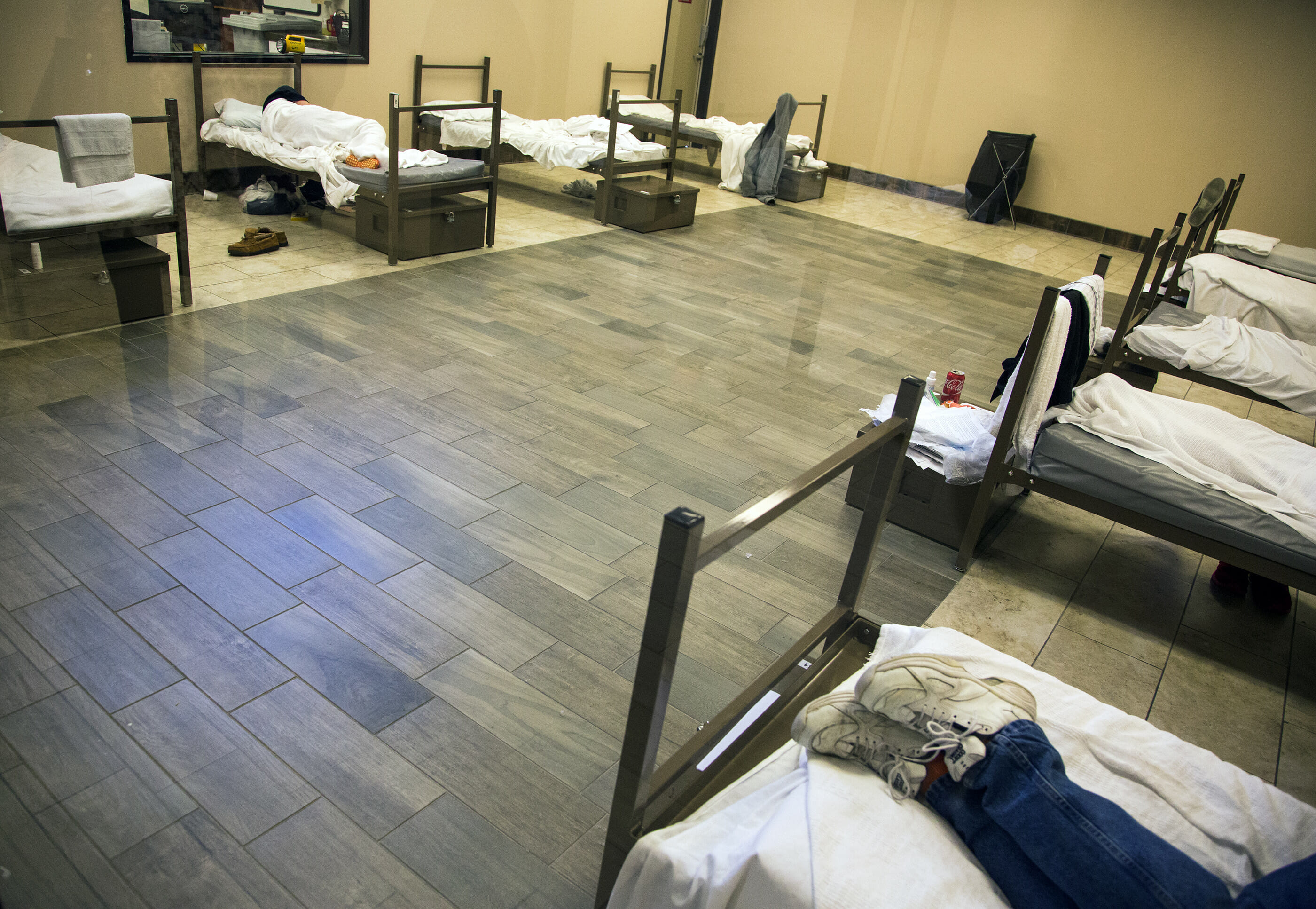
If Las Vegas City Councilman Steve Ross had seen the news, he would have recognized the man captured in surveillance images who had been robbing local businesses. It was his son.
But Ross was in Washington state at the time, so he missed coverage about what Metro Police had dubbed the “cruiser” robbery series based on the suspect’s modus operandi: The man would rob establishments at gunpoint and flee on a motorcycle, wearing a black helmet.
Several days later, the councilman’s phone rang. A detective was on the other end, waiting to deliver news that would shake Ross and his family to their core. His youngest child, Shane, now 28, had been arrested in connection with the armed robberies.
“It was a devastating call,” said Ross, who serves as mayor pro tem. That was in late August.
Today, Shane Ross sits in High Desert State Prison, serving an eight- to 22-year sentence for the crimes. It’s the end result of what his father calls a series of poor choices, fueled by an opioid addiction that followed a classic trajectory — a back surgery, a prescription for opioid-based painkillers and, ultimately, heroin use.
The Ross family knew about Shane’s struggles with heroin because he had been arrested for possession of the illicit drug at the end of 2015. They tried to get him help and, at one point, Shane even entered a recovery center, but he dipped out of the program before finishing, Steve Ross said.
Still, the family never expected Shane to feel so desperate for drug money that he would brandish a firearm and rob businesses like Tropical Smoothie and Burger King. Ross said it has been an “eye-opening experience” that has plunged him into advocacy work to raise more awareness about opioid addiction.
“That’s not who Shane is,” Ross said, referring to the crime spree. “The addiction overcame him.”
He’s far from alone. As opioids have taken control of an increasing numbers of lives, state lawmakers, community leaders and advocates have heeded the call to action, but despite initial legislative steps in 2015, the battle is far from over.
The Nevada Independent spoke with Republican and Democratic legislators and the attorney general’s office about bills they have introduced to tackle various aspects of the problem. Staff from Gov. Brian Sandoval’s office also released exclusive details about his forthcoming omnibus controlled substances bill. But those are just efforts on behalf of politicians.
Many treatment providers and prevention advocates see the devastation caused by the drug each day and have channeled their energy into mitigating its wrath.
By the numbers
As opioid abuse increased across the country, it sometimes seemed like a far-away problem relegated to small towns in the northeast, communities cradled in the Appalachian Mountains or downtrodden former manufacturing hubs. After all, that’s where the bulk of the problem’s media coverage has centered and where haunting images of people slumped over from heroin overdoses have originated.
But walk through the hallways of WestCare’s triage center in downtown Las Vegas, and it’s easy to see the potent drug’s grip on the desert city as well.
The nonprofit’s downtown location boasts 51 beds for men and women detoxing from substance abuse and, at any given moment, those beds belong to someone. It’s the same story with another 49 beds at a sister WestCare location less than two miles away: The need is great, so the beds play host to a new person as soon as the previous tenant leaves.
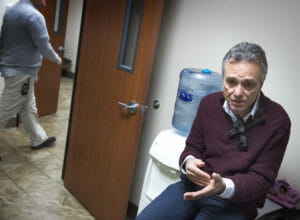
“We’re seeing more traffic in the community triage center than we ever have before,” said Bob Vickrey, communications director for WestCare.
The culprit? Opioids, he said.
On a yearly basis, the triage center serves about 4,500 clients. Of those people, about 24 percent were diagnosed with an opioid addiction upon intake in 2015, Vickrey said. Opioid diagnoses skyrocketed to 74 percent last year, meaning nearly three out of every four people who enter the center’s doors have an opioid addiction, he said.
“This is so out of hand,” he said. “We are out on the streets connecting with people most at risk, so we can try to intervene and educate.”
Opioid addiction generally begins with prescription painkillers — sometimes for a valid medical reason after an injury or surgery, other times for recreational use only. But when those pills run out and it becomes increasingly difficult and expensive to obtain more, users often gravitate to heroin, which is considered the cheaper alternative with the same end effect. A balloon of black tar heroin retails for about $10 on the streets, Vickrey said.
Numbers from the Clark County Coroner’s Office also paint a chilling look at what most health providers and law enforcers describe as an epidemic touching all corners of the community. Last year, the coroner’s office reported 367 opioid-related deaths in the county. That’s down from 411 such deaths in 2012, but in the past five years, the numbers have never dipped below 300.
And statewide data haven’t painted any prettier of a picture: Nevada has the fourth-highest drug overdose mortality rate, 20.7 per 100,000 residents in 2010, and the state’s doctors write 94 painkiller prescriptions for every 100 residents. Plus, 35 percent of the state’s high school students in 2013 reported having taken painkillers without a doctor’s prescription.
Joe Engle, who founded the Las Vegas chapter of an awareness organization called There’s No Hero In Heroin, doesn’t expect those numbers to subside anytime soon.
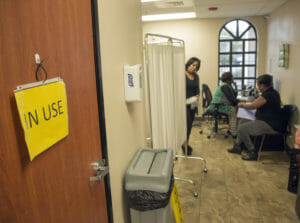
“We haven’t seen the worst of it yet,” he said. “Despite all of our best efforts, the numbers are increasing.”
Engle said the community needs to destigmatize addiction and provide a greater number of recovery-oriented resources, including more treatment beds for drug users who don’t have any kind of insurance — an all-too-common scenario after the addiction robs people of their financial security, personal relationships, jobs and housing.
“It’s going to cost money,” he said. “Somebody’s gotta pay it. But what price are we paying now? We are losing our kids.”
He’s speaking from experience. Engle’s 19-year-old son Reese died from a heroin overdose in July 2011. Since then, Engle has dedicated himself to raising awareness about opioid abuse and lobbying elected officials to better address the growing crisis.
A governor’s mission
The Legislature made a number of changes to try to mitigate the state’s prescription pill problem during the 2015 session — bolstering the state’s so-called prescription monitoring program (PMP) and expanding access to Narcan, an opioid overdose antidote — as part of an omnibus substance abuse bill, SB459.
Those changes, which came out of a 2014 task force spearheaded by First Lady Kathleen Sandoval, helped. The number of controlled substance prescribers enrolled to access the database jumped from 16 percent to 81 percent. Additionally, there’s been a 93 percent increase queries of the PMP, though those have been only from a small number of prescribers, according to Yenh Long, the PMP’s administrator.
Meanwhile, the city of Las Vegas recorded a 43 percent increase in the number of times paramedics administered Narcan, which blocks the effects of opioids and reverses an overdose, last year compared with 2015. They administered the medication 596 times in 2015 and 853 times in 2016. In unincorporated parts of Clark County, paramedics administered Narcan 591 times last year, county officials said.
Dr. David Slattery, who works in University Medical Center’s emergency department, said he conducted Narcan trainings with about 100 community members last year. He hopes to train just as many people on how to administer the opioid antidote this year.
Despite those steps in the right direction, the felony indictment of a Reno doctor who federal authorities said was at the center of an alleged “pill mill” operation last May brought the issue into sharp focus again, making it clear to state officials and other stakeholders that there was more work to be done.
Dr. Robert Rand allegedly ran an illegal prescription drug ring resulting in the death of Michael Yenick, a 33-year-old former Nevada Wolf Pack football player, in October 2015. Eight other defendants were arrested in connection with the case, though only Rand was charged in Yenick’s death.
Mike Willden, chief of staff to the governor, said the Rand case widened the focus of the prescription drug crisis in the state, bringing law enforcement, first responders and other public health officials to the table. The governor, whose office was in the process of mapping out its 2017 legislative priorities, decided to call an all-day prescription drug planning meeting in June to bring together a diverse group of organizations, agencies and individuals.
“The governor, I’ll just say he was pretty moved by the Washoe County situation,” Willden said. “We had law enforcement in here frequently saying it’s a bad situation out here and we needed to do more.”
Out of the planning meeting, the governor called a two-day summit at the end of August that brought together roughly 500 people, including Democratic Vermont Gov. Peter Shumlin and then-U.S. Department of Agriculture Secretary Tom Vilsack, to develop what would become a 17-page recommendation on how to mitigate Nevada’s prescription drug crisis.
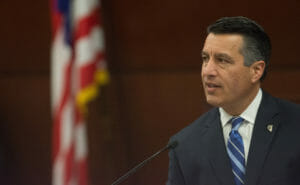
But the ultimate product of that summit is the governor’s yet-to-be released omnibus bill, which he called the “Controlled Substances Abuse Prevention Act” in his January State of the State address. The bill, as detailed to The Nevada Independent in an interview with the governor’s staff, makes a number of specific but wide-ranging changes to the way doctors, law enforcement and public health officials respond to the opioid crisis.
“We lose one Nevadan every day to opioid overdose — a mother, father, son, daughter, grandparent or close friend,” Sandoval said in his address. “This has been a growing problem for over a decade, and has now reached levels of epidemic proportion.”
Piggybacking on the 2015 session, the legislation will ensure all doctors are registered for the PMP, implement new rules about when doctors are required to access that database and expand the number of people who can access it.
SB459 required all doctors who write prescriptions for controlled substances to enroll in the PMP, but roughly 10 percent of prescribers have yet to do so, according to Long. She said her statistician creates a new list every two months of prescribers with controlled substance licenses who have yet to register, which then is passed along to the boards that license the health professionals. (Doctors, nurses and dentists all are overseen by different boards.)
From there, the boards send notices to members reminding them that they need to register with the PMP in order to be compliant with the new law. But that’s easier said than done.
Edward Cousineau, executive director of the Nevada State Board of Medical Examiners, said the PMP expansion has been a “huge administrative burden” for the board, though the database is a “great tool to have.”
“We try the best we can, but the problem is the sheer numbers,” Cousineau said. “We have 7,000 licensees that prescribe. With a staff of 30 with two attorneys, we’ve tried the best we can to get people on board, and we continue to try and do that.”
Still, the governor’s new legislation seeks to boost the number of controlled substance prescribers registered with the PMP to 100 percent or as close as possible by requiring prescribers to demonstrate they have registered for the database upon the renewal of a controlled substance license, which happens every two years.
It also makes changes to when prescribers are required to access the database. Under SB459, a PMP check was only required for an initial controlled substance prescription in excess of seven days or if the patient was new to the prescriber. The new legislation will require a database check for any initial prescription and then every 90 days after that.
“Really it's additional data for the physician to have in order to really engage the patient in meaningful conversations around prescribing,” said Dr. Stephanie Woodard, a clinical psychologist with the Nevada Division of Public and Behavioral Health.
Beyond that, the legislation gives teeth to licensing boards to act on information provided by the PMP. The database was initially established to catch so-called “doctor shoppers” — people who jump from physician to physician, accumulating multiple scripts for controlled substances — but has been used more recently to catch doctors who appear to be overprescribing.
Right now, the PMP pulls a list of the top prescribers in Nevada and provides their names to their respective licensing boards, but it’s up to the individual boards to decide if or how to act on the information, Long said.
The problem was that some boards weren’t able to investigate into whether their licensees were prescribing a higher-than-expected amount and ask for patient records without opening a formal investigation, said Elyse Monroy, the governor’s health and human services policy analyst. The legislation will allow boards to open up an administrative review into a prescriber before proceeding to a full-blown investigation.
“If Dr. Johnson or whoever is prescribing high, they can take a look at those records and see maybe it’s pain management, maybe it’s oncology, maybe it’s a warranted high prescribing,” Monroy said. “If they haven’t followed the prescribing protocols, then there’s a problem and then it can go to an investigation.”
It also gives the boards the power to suspend controlled substance licenses if there’s a threat to public safety or public health. But, as Cousineau noted, “99.9 percent” of doctors “are doing the right thing.”
“Unfortunately, that small percentage can have a major impact on the patient populace and gets all the notoriety,” Cousineau said.
The legislation will also limit how much of a controlled substance a prescriber can administer. It implements a 14-day cap for acute initial prescriptions, caps opioid doses at 90 morphine milligram equivalents per day and creates a “prescribe 365” policy, which states that patients should not be able to receive any more than a year’s worth of medication within a year.
“There no reason an individual should receive 450 days or 600 days of a medication within 365 days,” Woodard said.
Though the legislation has been developed through conversations with the various licensing boards and other stakeholders, there’s still the potential for individual doctors and other controlled substance prescribers to take issue with some of the proposed regulations.
“The one thing I tell people constantly is doctors don’t want legislation or regulation that inhibits their ability to treat a patient subjectively,” Cousineau said. “Each circumstance is unique.”
Other changes included in the bill will allow paramedics to access the PMP, allow law enforcement officers to aggregate gram counts when enforcing controlled substance laws, bump a one-hour continuing substance abuse education recommendation to a two-hour requirement and requiring the real-time data reporting of suspected or actual drug overdoses to the state.
That last part is particularly important in treating overdoses as a public health issue and disseminating that information across the state, Woodard said. The Centers for Disease Control and Prevention has indicated that the upward trend of opioid-related deaths is now similar to that of the human immunodeficiency virus (HIV) epidemic in the late 1980s and early 1990s.
“The opioid epidemic across the nation is one that is very complex. There's no one solution to address the problem,” Woodard said. “I think with the bill we've been able to put forth as well as SB459 we were able to address things we could directly affect and then working with individuals at the community level, the public health authorities to make sure when and if there is an uptick in illicit substance use, including heroin, that we know.”
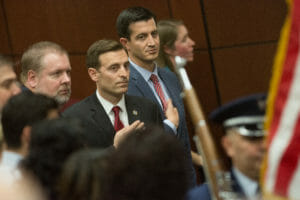
The attorney general’s office is also putting forward a bill, SB59, that requires law enforcers to upload information about prescribed controlled substances they encounter in the course of their work to the PMP. The bill is a byproduct of the Substance Abuse Working Group, chaired by Attorney General Adam Laxalt.
"Nevada’s Substance Abuse Working Group is pleased to submit this bill that will help local law enforcement keep our communities safer and healthier by more strictly monitoring and reporting instances related to substance abuse,” Laxalt said in a statement.
Other legislative efforts
Other legislators, Republican and Democratic alike, are bringing forward or co-sponsoring other pieces of legislation that they hope will mitigate the opioid epidemic in the state. For some of them, it’s personal.
Republican Assemblywoman Jill Tolles shared the story of a family member who became addicted to painkillers after a work-related accident. That addiction led to an illegal drug addiction, which then led to an overdose from which he died.
“It’s personal to us because we’ve lived through that experience,” Tolles said.

Tolles has signed on as a co-sponsor to a bill brought forward by Republican Sen. Heidi Gansert, SB171, which would require all pharmacies in the state to provide a means of disposal for unused drugs, like opioids. One option is for pharmacies to sell bags containing carbon, which bonds to the drugs when water is added.
“I've talked to some pharmacies, and typically what happens is there may be a day every now and then where they can gather unused prescription meds, but it's actually pretty costly for them to be able to do that,” Gansert said. “So this is a really inexpensive alternative to be able to dispose of unused medications.”
Gansert has a second bill, SB162, which would create a registration process for psychological assistants, interns and trainees and require their services to be reimbursable through Medicaid. Gansert hopes that her legislation will expand access to behavioral health services in the state, including for those struggling with addiction.
“It's really a pretty simple bill but it allows these mid-level providers to register, which will allow (patients) to get Medicaid reimbursement which will enhance that pipeline,” Gansert said.
Democratic Assemblywoman Daniele Monroe-Moreno, a former corrections officer, is also sponsoring a bill, AB194, which provides for the certification of behavioral health care peer recovery support specialists, non-professional, non-clinical specialists who work under psychiatrists and psychologists.

“Sometimes talking with someone who's been through what they've lived through and gotten past it to the other side helps them more in their recovery because they've lived those personal life stories,” Monroe-Moreno said.
But Independent Sen. Patricia Farley worries that even if Nevada is able to stamp out its prescription pill problem entirely, addicts will just turn to buying drugs on the streets. That’s why she’s focusing on how to educate middle, junior and high school students about the opioid crisis.
“I think government does what it always does and look to decrease the harm without addressing the full scope of the problem,” Farley said. “So I think we need to change our thinking here.”
Her bill, SB166, would establish an annual survey of drug use among middle, junior and high school students. Farley said the ultimate goal is to use that information to bolster drug prevention efforts in Nevada’s schools, pointing to the success of a Canadian program called Preventure that offers personality-targeted substance abuse intervention.
She hopes that early intervention and education will prevent people from going through what she has endured while helping her brother James with his addiction problems over the years. Farley said she learned more sitting through one family group session at her brother’s in-patient rehab center than she did in 20 years growing up with him.
“It would've changed potentially how my family would've handled things, when I actually understood what enabling was, when I actually understood the power of the drug, that it's not him making bad choices, it's that he's no longer able to make good choices,” Farley said. “I just think that we do a bad job of getting this information out to people.”
Democratic Assemblyman Mike Sprinkle, a firefighter-paramedic by profession who chairs the Health and Human Services Committee, said he’s particularly concerned about people turning to illicit drugs as the state tightens regulations on prescription painkillers. Sprinkle emphasized the need for long-term rehabilitation programs for those addicted to narcotics.
As a paramedic, “I can give medication to reverse the overdose, but all it does is stop the immediate,” Sprinkle said. “They're going to be potentially right back in that situation the next day. We need to look at those long-term rehabilitation programs and dealing with the addiction problem as well.”
Harm reduction strategies
But even the best legislation and prescription drug-monitoring systems won’t fully eradicate the opioid problem. People seeking the drug’s euphoric high will continue popping pills or injecting heroin.
That’s where Trac-B Exchange comes into play. Located at the corner of Charleston and Jones boulevards, it’s a place where people can obtain clean needles and other injection-related supplies free of charge, said Chelsi Cheatom, the program manager. The organization is working with the Southern Nevada Health District and another nonprofit.
Trac-B Exchange, which opened Feb. 2, is the only Southern Nevada storefront that provides “harm reduction” services to people who use needles, whether for illicit drugs, steroids, hormones or insulin, Cheatom said. The idea is to protect residents against the spread of HIV or Hepatitis C.
Earlier this month, the organization set up a table at a downtown event aimed at helping homeless people living in the area. Within the first hour, Cheatom said the group had given away all the clean needles and other supplies it brought.
“It’s something that’s really needed in our community,” she said.
Trac-B Exchange is part of a newly formed group called the Harm Reduction Coalition, spearheaded by the health district, that’s examining ways provide even more preventive care for this population, said Jenny Gratzke, a disease investigator and intervention specialist with the health district. The coalition is looking at ways to improve mental health services, provide affordable treatment and recovery, prevent overdoses and increase safer needle use, she said.
The group is basing some of its decisions off an August survey targeting drugs users, both those living on the streets and in tunnels as well people in medical facilities, that asked them what kind of services they’d like to see, Gratzke said. It’s the first survey of its kind done in Southern Nevada since 2001, she said.
Beyond legislation, state agencies are also trying to take steps to address the substance abuse prevention and treatment through other methods.
The Nevada Board of Medical Examiners recently launched a website to help educate the community about how opioids work, what the state’s prescription monitoring program is and which board to contact if they have any concerns about a controlled substance prescriber. The attorney general’s office has also been participating in the National Prescription Drug Take Back Days, with the next one scheduled for April 29.
Stopping the stigma
As Steve Ross and his family cope with the aftermath of Shane’s drug addiction and imprisonment, the councilman hopes their experience can serve as a cautionary tale for others in the community.
The problem is real, he said, and it doesn’t discriminate: Addiction can touch people living in all parts of the state. That’s why widespread awareness is key.
“I didn’t want to stick my head in the sand and pretend this didn’t happen,” he said. “We want people to be aware of this epidemic in the community.”
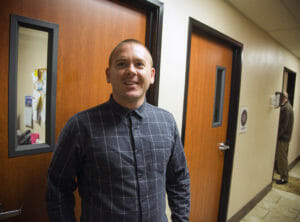
Recovery, however, ultimately hinges on the drug user’s acknowledgment of the problem and willingness to seek help. Just ask Tyler Toltzman, who recently celebrated his one-year anniversary of being drug free.
Toltzman began dabbling in recreational pill use several years ago and eventually made the transition to heroin. His addiction held such a strong grip on him that Toltzman didn’t feel like he could perform his job as a grocery store’s dairy manager without the added boost of a drug.
Like so many other users, his addiction landed him in jail. He spent seven months in the Clark County Detention Center and then transferred to a residential treatment program at WestCare’s Harris Springs Ranch location.
These days Toltzman often carries a lanyard with him that has tags for each sobriety milestone he achieves. It’s a day by day — sometimes hour by hour — process to stay drug free. He credits his faith for guiding him in the journey. And he wants others to know that, yes, recovery is possible, but it takes hard work.
“Once you believe and you know you want it, you’re halfway there,” he said. “That’s the hardest part. Don’t wait. Get help before it’s too late because you’re going to regret it.”
Lead photo caption: A client lies on a bed at WestCare Nevada Community Triage Center, 323 N. Maryland Parkway, on Thursday, Feb. 24, 2017. Photo by Jeff Scheid.

